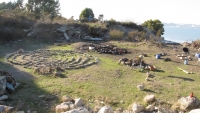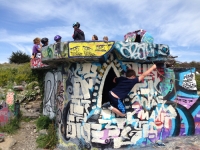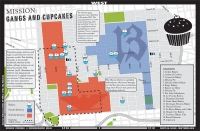Publication: No Cruising: Mobile Identities and Urban Life
The first Global Urban Humanities research studio, “No Cruising: Mobile Identities and Urban Life” took place in Spring of 2014, co-taught by Margaret Crawford (Architecture) and Anne Walsh (Art Practice). With six PhD students, three MFA candidates, and one undergraduate student from a diverse set of disciplinary backgrounds, the course took on Los Angeles and the multiple themes generated by the concept of mobility (and its inverse: immobility). Over the course of the semester, students visited LA multiple times and explored the city via car, bus, light rail, walking, and running, focusing on the circulation of bodies, stories, designed forms, performance, identities, labor, opportunities, and relationships.

Out of the studio comes a new publication documenting these projects, also titled No Cruising. Student essays are accompanied by rich images of urban life, archival materials, and maps that reflect the social, political, cultural, and environmental histories that shape current experiences of movement and entrapment within the city infrastructure. These projects upend dominant myths of the city (spoiler alert: people do walk!) and disturb established spatial arrangements through performance and imagined design.

As the faculty advisors write in their introduction, “The No Cruising projects address human agency–transit activists, artists and gallerists, teenage drag queens, and Midwestern, Mexican, and Taiwanese immigrants–as well as monumental forms like the Watts towers and palm trees, and finally the expressions of invisible but potent agents such as seismic and spiritual force fields.” This beautiful publication weaves together distinct experiences across a landscape, offering readers a chance to dive into the many complex threads that make up life in this iconic city.

Students in the course:
- Ying Fen Chen, Architecture PhD
- Sarah Cowan, Art History, PhD
- Jason Fritz, Art Practice, MFA
- Megan Hoetger, Performance Studies, PhD
- Kathleen Irwin, Architecture, MS
- Lee Lavy, Art Practice, MFA
- Fabian Leyva-Barragan, Art History, Art Practice, and German, BA
- Michelle Ott, Art Practice, MFA
- Sabrina Richard, Architecture, PhD
- Noam Shoked, Architecture, PhD
- Alec Stewart, Architecture, PhD
The Albany Bulb and Ephemeral Layers of Territory
 As part of the Global Urban Humanities Initiative Colloquium called Reading Cities, Sensing Cities we have asked students and visitors to write responses to each of the weekly guest lectures. October 30, 2014 Nature, Culture, and Conflict at a Shoreline Landfill: The Albany Bulb Susan Moffat (Global Urban Humanities Initiative) Moffat presented on The Atlas of the Albany Bulb, her oral history and mapping project about a landfill on the eastern shore of San Francisco Bay, which has been the location of bitter battles between people holding different notions of the proper uses of public space, and of what a…
As part of the Global Urban Humanities Initiative Colloquium called Reading Cities, Sensing Cities we have asked students and visitors to write responses to each of the weekly guest lectures. October 30, 2014 Nature, Culture, and Conflict at a Shoreline Landfill: The Albany Bulb Susan Moffat (Global Urban Humanities Initiative) Moffat presented on The Atlas of the Albany Bulb, her oral history and mapping project about a landfill on the eastern shore of San Francisco Bay, which has been the location of bitter battles between people holding different notions of the proper uses of public space, and of what a…
Bay Area Landscapes and the Conflict Over Open Space
 As part of the Global Urban Humanities Initiative Colloquium called Reading Cities, Sensing Cities we have asked students and visitors to write responses to each of the weekly guest lectures. October 30, 2014 Nature, Culture, and Conflict at a Shoreline Landfill: The Albany Bulb Susan Moffat (Global Urban Humanities Initiative) Moffat presented on The Atlas of the Albany Bulb, her oral history and mapping project about a landfill on the eastern shore of San Francisco Bay, which has been the location of bitter battles between people holding different notions of the proper uses of public space, and of what a…
As part of the Global Urban Humanities Initiative Colloquium called Reading Cities, Sensing Cities we have asked students and visitors to write responses to each of the weekly guest lectures. October 30, 2014 Nature, Culture, and Conflict at a Shoreline Landfill: The Albany Bulb Susan Moffat (Global Urban Humanities Initiative) Moffat presented on The Atlas of the Albany Bulb, her oral history and mapping project about a landfill on the eastern shore of San Francisco Bay, which has been the location of bitter battles between people holding different notions of the proper uses of public space, and of what a…
Road-Testing Psychogeography on Oakland’s International Boulevard
 As part of the Global Urban Humanities Initiative Colloquium called Reading Cities, Sensing Cities, we have asked students and visitors to write responses to each of the weekly guest lectures. On September 4, 2014, Darin Jensen invited listeners to consider the narrative and spatial aspects of two experiential mapping projects he created with his students: Mission Possible: A Neighborhood Atlas about San Francisco's Mission District, and Intranational International Boulevard about Oakland. Jensen is staff cartographer and lecturer in the UC Berkeley Department of Geography. His presentation is available here. Video of the first portion of his presentation is available here. By Scott Elder While not…
As part of the Global Urban Humanities Initiative Colloquium called Reading Cities, Sensing Cities, we have asked students and visitors to write responses to each of the weekly guest lectures. On September 4, 2014, Darin Jensen invited listeners to consider the narrative and spatial aspects of two experiential mapping projects he created with his students: Mission Possible: A Neighborhood Atlas about San Francisco's Mission District, and Intranational International Boulevard about Oakland. Jensen is staff cartographer and lecturer in the UC Berkeley Department of Geography. His presentation is available here. Video of the first portion of his presentation is available here. By Scott Elder While not…
Maps as Stories: Manufacturing Place
 As part of the Global Urban Humanities Initiative Colloquium called Reading Cities, Sensing Cities, we have asked students and visitors to write responses to each of the weekly guest lectures. On September 4, 2014, Darin Jensen invited listeners to consider the narrative and spatial aspects of two experiential mapping projects he created with his students: Mission Possible: A Neighborhood Atlas about San Francisco's Mission District, and Intranational International Boulevard about Oakland. Jensen is staff cartographer and lecturer in the UC Berkeley Department of Geography. His presentation is available here. Video of the first portion of his presentation is available here.…
As part of the Global Urban Humanities Initiative Colloquium called Reading Cities, Sensing Cities, we have asked students and visitors to write responses to each of the weekly guest lectures. On September 4, 2014, Darin Jensen invited listeners to consider the narrative and spatial aspects of two experiential mapping projects he created with his students: Mission Possible: A Neighborhood Atlas about San Francisco's Mission District, and Intranational International Boulevard about Oakland. Jensen is staff cartographer and lecturer in the UC Berkeley Department of Geography. His presentation is available here. Video of the first portion of his presentation is available here.…




